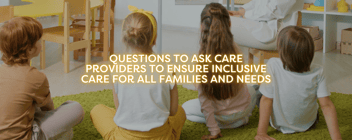Four Ways Companies Can Help Close Family Wellness Gaps
Company wellness plans need help. Correction: employees need help accessing helpful benefits they have no idea are available to them.
The good news? More companies are investing in benefits that span their employees’ full spectrum of life experiences, weaving Diversity Equity and Inclusion (DEI) strategy into employee health strategy. One category of benefits that companies are investing in is care benefits. Care benefits help employees manage child and dependent care responsibilities at home, and they can range from babysitters to full-time nannies, to programming and transportation.
The bad news is, employees aren’t using their care benefits enough, and they’re continuing to manage family care responsibilities on their own.
Why Employees Aren’t Using Their Family Care Benefits
Availability is not access.
A consistent challenge to increasing care benefit utilization is that very few managers and employees know anything about their own care benefits. In a recent Harvard Business Review (HBR) Pulse Survey, 64% of participating executives reported that the most common challenge employees experience when using their benefits is that they aren’t even aware of them.
Some employees are aware that they exist, but they either don’t know how to access them or feel too overwhelmed to navigate their regional network of options. According to the HBR survey, more than half of executives say that a big challenge to driving benefits utilization is that employees have difficulty navigating and understanding their benefits.
And even if an employee is lucky to land up with an empathic boss who can create a safe space to discuss benefit needs or time off to navigate their benefits, managers are often ill-equipped to guide their team members on what to do next.
When combined with complex provider systems, these gaps in knowledge and understanding often lead employees to fend for themselves.
Family wellness isn’t considered a talent strategy, but it should be.
Another intersectional challenge is that most companies still haven’t added caregivers to their inclusive talent strategy. Striking, considering a majority of American workers care for someone on a daily basis and over 40% of working parents with school-age children had to shift their job situation to navigate this pandemic.
Clearly, if we want to close family wellness gaps, increasing care benefits alone won’t cut it. We need better ways to connect employees to their care benefits so that in their moment of need, they actually use them.
Below are four effective ways you can help employees use their family care benefits.
Communicate Family Benefits Information Via Curated Resource Hubs
Low utilization of family-friendly benefits typically results from too few resources being invested in communication on the subject. When communication efforts are lacking, employees don’t know their benefits exist, and they’re very unlikely to go searching for them in their onboarding package… which is probably under a pile of documents somewhere in their house.
This is a problem. As Jennifer Benz, a benefits communication expert, put it, “If you don’t communicate about benefits, you may as well not offer them at all.” If employees don’t know about their benefits, then they lose out on savings and employers lose out on the returns they hoped to gain on their investment. Over time, employers get a false read of what workers really need.
User-friendly resource hubs will help bridge the benefits awareness gap and improve overall family wellness. If done right, your resources will:
- Break employee benefits down by type and region
- Be searchable
- Contain easy-to-use “how to” resources
- Answer common questions
- Include a point-of-contact for every benefits category
Once you have your resource hub in place, communicate your benefits to your employees on a regular basis through multiple channels, including in-person communication. A constant pulse of internal employee communications pointing to a curated resource hub will help increase awareness, education, and most importantly, adoption rates.
Need some inspiration? Here are some of our favorite employee benefits resource hubs:
- Salesforce’s Benefits Home Page
- Target’s Benefits and Wellbeing Website
- Starbucks’ Partner Benefits Page
-
Train Your Managers on the Ins and Outs of Care Benefits
According to a recent McKinsey study on mental health benefits at work, when it came to benefits awareness, manager-led communication was second only to company benefits websites…ahead of communications from human resources.
Front-line managers are in the best position to understand what their employees need. They’re most likely to build a rapport with employees and naturally more likely to learn of changes in an employee’s family life—changes that may impact their family benefits needs—before HR does.
So, if you want employees to use their family care benefits, enable managers to understand the ins and outs of care benefits for every stage of life by integrating care benefits education from onboarding training to 1:1 meetings.
Brand Your Family Benefits to Encourage Use and Attract Talent
What’s missing from your own story to attract and retain today’s talent? If we know Millennials and GenX job-seekers expect family-first benefits, does that show through? Do employees feel safe to use their benefits?
The umbrella question here is: Are you branding family care benefits packages in a way that encourages use?
Branding your benefits to promote use is key. Even if companies educate their employees on what benefits are available and how to use them, if using those benefits isn’t the cultural norm, then it won’t happen. Of course, branding your benefits message isn’t an overnight project. It will take time. Still, there are few steps you can take to get started on the right path.
Use External Audits to Gauge Competitor Messaging
External compensation audits have been a longstanding component of HR compensation strategies...but they’ve historically focused on salaries and traditional benefits like health insurance and 401(k) plans. Now, times have changed.
By exposing caretaking inequities at work, the Covid-19 pandemic spurred many companies to re-think their benefits packages and shift their strategic compensation lens from salaries and fun perks to family-centered care benefits that prioritize family wellness. If other companies want to compete for new talent, they’ll have to do the same.
Focused studies of competitor care benefits, or even mini audits studying competitor career sites, can help you gauge how your competition is communicating their benefits to candidates and employees. More importantly, these studies will help you create your own benefits story.
Look Inward... What Are Your Employees Telling You?
A recent study by the Pew Research Center found that many employees don’t use their family (or medical) benefits because they don’t feel safe using them. More than half of employees were afraid of losing their jobs, and 40% feared using their benefits would hurt their chances of advancing in the company.
These trends tell us that most employees don’t believe family wellness is a company priority. If companies want to change that, they need to send the right message to their employees.
To start this process gather employee sentiments and keep positive benefits conversations going through questionnaires, 1:1 meetings, and discussions with employee resource groups (ERGs) if you have them.
Track Your Progress with Targeted Data
Another contributor to low utilization of family care benefits is a lack of benefits data. Currently, about one-third of organizations don’t track benefits usage at all, while another 20% aren’t sure if they do. Without data, companies can’t make necessary adjustments to their benefits programs because don’t know who’s using them.
Luckily, human resource data reporting and surveying capabilities have skyrocketed in the last decade, allowing companies to see what’s working and what needs to change down to a granular level. With the technology there, what companies really need is advocacy.
To track family benefits use in your organization, advocate adding caregivers to employee-sentiment surveying, pay gap analysis, and EEO-1 data reporting. If you need to increase your data capabilities, consider investing in intelligent DEI software like Included.ai or Crescendo.
With transparent data measuring how working families are thriving or need more attention in their career progress, companies can take action to help employees use their care benefits to solve family wellness issues before they become problems.



